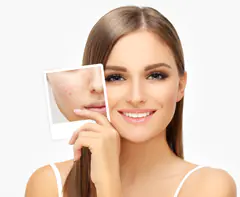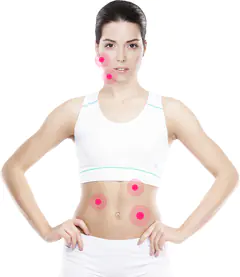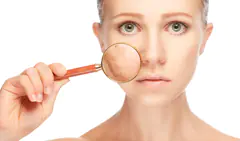A woman’s face is a kind of “showcase” of appearance. That is why it is necessary to take into account the stages of facial skin care when performing daily cosmetic procedures. After all, the face is exposed to external and internal conditions.
Malfunctions in the functioning of the body, sleepless nights, exposure to wind or, on the contrary, the rays of the sun, all this is reflected as a carbon copy on delicate skin. For this reason, caring for her must be systematic, competent and step-by-step.
There are some basic, universal rules that apply to absolutely any skin type (this includes the stages of applying some cosmetics). But the rest of the care needs to be tailored strictly to yourself.
We will help you understand what your skin requires!
Rules for facial skin care
For complete, and most importantly, high-quality facial skin care, you should choose everything you need and need for each type of skin from the list. The care list, in general, is small and includes only a few items for everyday facial care. Although at first glance this entire complex may seem numerous and difficult to implement, there is nothing complicated about it. The main thing is to outline the steps necessary for a particular woman’s skin and move in a given direction purposefully and systematically.
The main law of beauty is the need for daily facial skin care. Fatigue, lack of time, banal laziness should not stand in the way of beauty and grooming. Makeup must be washed off, skin care products applied to the skin, peelings and masks are carried out at certain intervals. This is the base. The foundation, without which the appearance of the dermis will never become well-groomed and pleasing to the eye. That is why step-by-step care should be practically “hammered” into the daily routine of every self-loving woman.
The application of cosmetics during the day and during evening care must certainly be done along the massage lines. This will help the cosmetics absorb faster and avoid stretching of the dermis, which can occur if the fingers are moved incorrectly. The main massage lines are:
- from the chin to the earlobes;
- from the corners of the lips to the earlobes;
- from the bridge of the nose to the temples;
- from the outer corners of the eye to the inner (movements along the upper and lower eyelids);
- from the collarbones to the chin up the center of the neck;
- from the earlobes to the shoulders on the sides of the neck.
Basic stages of facial skin care
The main stages of facial skin care are as follows:
- cleansing;
- toning;
- hydration;
- applying cream.
Facial skin care at home involves the use of peelings and masks. But these steps are considered periodic because they are not performed daily.
The primary stage of complete daily facial care is skin cleansing. Dust, cosmetics, sebum, toxic substances of the modern environment readily clog the pores of the face almost every minute. Of course, all excess accumulated during the day must be removed. Otherwise, comedones (blackheads), acne, inflammation and other minor and major troubles will most likely appear on your face. For this reason, cleansing of the dermis must be thorough and regular.
Following the care sequence, the cleansing is followed by a toning process. Toners remove remnants of cleansing cosmetics from the face and give the skin a fresh look. The tonic helps narrow pores, cellular renewal, restore acid balance and relieve inflammation.
A facial will not be considered complete if the face is not moisturized. This can be achieved by using moisturizing creams, sprays and lotions. They will help restore the skin's water balance.
Find out more about the stages of facial skin care:
How to apply cream on your face?
The cream, selected taking into account your skin type, is suitable as a skin care product for every day. It is very important to apply cosmetics correctly. Then it will have a better effect. Having completed the remaining preliminary stages of basic care, you can begin to distribute the cream over your face.
A small amount of cream is squeezed onto the palm. Distribute the product with careful movements. Leave the cream until completely absorbed. The remains are rubbed over the surface of the hands.
Important! You don’t need to skimp on the amount of product, but you shouldn’t apply too much of it either.
Sequence of facial skin care in popular questions
Modern man is very mobile. We are constantly striving somewhere, running, walking - to the bus, up the career ladder, towards our goals. So why not start taking steps towards amazing, youthful skin? Moreover, these steps will not require any excessive effort.
So, step-by-step instructions for daily facial care look like this:
Step 1: Wash your hands. Touch your face exclusively with clean hands.
Step 2. Remove eye makeup. For this purpose, a special product (hydrophilic oil, micellar water) is suitable, which must be applied to a cotton pad and lightly moved along the eyelids, removing any remaining makeup.
Apply cleanser to face and neck using fingertips. After a minute, rinse with warm water.
Step 3. Moisten a cotton pad with toner. Gently rub the skin along the massage lines.
By the way. If a tonic is used in the form of a spray, it is sprayed over the face and gently driven into the dermis with light movements of the fingertips. The product can also be distributed with a cotton pad.
Step 4: Apply moisturizer. This process is carried out twice a day - morning and evening, distributing the product along the massage lines.
Important! Day cream is applied half an hour before going out into the air (an hour in winter) so that it has time to be absorbed. Night cream is applied about an hour before bedtime.
It is recommended to tidy up your facial skin with cleansers and water. But is all water suitable for such a delicate procedure? What water is best to use?
Ideally, use filtered water free of chlorine. But it is also acceptable to wash your face with tap water. Its contact with the dermis when washing lasts no longer than a few seconds, and the tonic applied afterwards neutralizes the effect of all “unhealthy” substances.
Yes. Can. But after such a procedure, you need to wipe the skin with a cotton pad soaked in water or tonic. This will remove any remaining cleaning products.
When caring for your delicate facial skin, you shouldn’t forget about washing your face every day. Complete facial skin care involves at least two washes - morning and evening. This approach will allow you to cleanse your skin after sleep or a day of work and prepare it for subsequent skin care stages.
The subtleties of the facial skin care process depend on the woman’s age. Very young girls do not need to apply night cream. All you have to do is cleanse your face and apply toner.
Having crossed the twenty-five year mark, ladies are recommended to perform all skincare procedures without exception.
Seasonality in facial care also plays an important role. Facial care in summer differs from the same procedure in winter. Although the basic sequence of stages is usually preserved. In winter, it is worth using protective products that protect your skin from negative weather influences. Moisturizer is applied exclusively at night. It is unacceptable to go outside immediately after applying the product.
Summer care is aimed at moisturizing the dermis. In warm weather, it is recommended to apply natural-based masks more often: fruit, clay, vegetable, etc.
Many girls doubt the advisability of using tonic in facial care. But it is preferable for everyone to use the tonic. It is preferable to choose a product for your skin type that performs suitable functions. Thus, according to functionality, tonics are divided into moisturizing, refreshing, astringent, exfoliating and others.
The sequence of actions in facial skin care is a mandatory condition. Three main steps - cleansing, moisturizing, toning - a woman should do every day, moving towards well-groomed and youthful skin. Regular care procedures in tandem with high-quality cosmetics will help achieve stunning results.
A woman’s face is perhaps the most unprotected part of the body; it is susceptible to almost all external influences. In addition, internal problems of the body are immediately reflected in her condition and become visible to others. That is why facial skin needs careful daily care, which will help restore it to a healthy and radiant appearance, give it elasticity, and preserve youth. Like any cosmetic procedures, home care should not only be systematic, but also correct.
Content:
- Determining your skin type
- Principles of proper care
- Cleansing.
- Washing.
- Peeling.
- Cleansing masks.
- Hydration.
- Toning.
- Nutrition.

Determining your skin type
To select the right care and cosmetic products, you need to know your skin type in order to direct your care in the right direction, solving a specific problem. It wouldn’t hurt to consult a cosmetologist who will not only determine but also tell you how to properly care for a certain type of facial skin. However, this can be done independently, knowing some features:
- Dry skin is caused by narrowed pores and tightness; it is prone to premature aging and the appearance of wrinkles, so it needs intensive moisturizing.
- Enlarged pores and oily shine accompany oily skin that is prone to inflammation, acne and comedones. Proper cleansing will help avoid many problems with such skin.
- Normal skin is characterized by the absence of these shortcomings, but it also requires daily care. The wrong selection of cosmetics can provoke various skin diseases.
- Sensitive skin reacts to any external or internal influence with redness and peeling. Special products for sensitive skin do not contain aggressive substances, fragrances or other components that can lead to such manifestations.
- Combination skin type is considered the most difficult in terms of choosing skin care products. Here it is important to correctly differentiate problem areas and select cosmetics in accordance with the identified problems. It should be remembered that products labeled “for combination skin” are just a marketing ploy.
In addition to the above, we can highlight such a problem as the manifestation of a capillary network, which reveals weak blood vessels. Cuperosis is not just a cosmetic defect, but also a serious disease; if you discover it, you should consult a doctor. Loose or aging skin is not only an age-related problem; it is quite common in women after 30 years of age with improper or irregular care. Timely measures will restore elasticity to the skin.
Principles of proper care
The rules for daily home care are based on cleansing, moisturizing, toning and nourishing the skin. Only such an integrated approach will achieve the desired effect and prolong the youth of the skin, preserving it and protecting it from negative influences - both external and internal.
The first and, perhaps, main stage in facial skin care is daily cleansing. During the day, dust settles on the skin, harmful substances from the environment and sebum accumulate. Here we will add foundation, powder, and other decorative products. This cocktail not only clogs pores, leading to inflammation, the formation of blackheads, comedones, acne and other troubles, but is also perfectly absorbed by the skin, causing its intoxication. That is why facial skin cleansing should be correct and regular.
Before washing, makeup and dirt accumulated during the day are removed with special skin cleansing products. This could be lotion, milk or micellar water. For lovers of natural home remedies, there is a recipe that many actors use when removing makeup. Heat any vegetable oil slightly, apply a thin layer, and after a minute remove it from the face. The oil will not only cleanse the skin, but also moisturize it.
For direct washing, it is better to use purified water, since the skin tends to absorb substances contained in the liquid. Ideally, use rain or melt water, but filtered tap water will also work. At the same time, cosmetologists advise abandoning soap, since the alkali it contains has a detrimental effect on the water balance of the skin. It is better to give preference to gel, milk or foam for washing.
Once or twice a week, peeling is carried out with a specially selected scrub. This procedure is designed to exfoliate dead cells, smooth out the surface, and deeply cleanse the pores. Scrubs are applied to damp skin and rubbed in with light movements, without much pressure. It is worth remembering, however, that in case of severe rosacea, severe inflammation or irritation of the skin, the peeling procedure is contraindicated.
It’s easy enough to make homemade face scrubs. To do this, use fine sea salt, sugar or ground coffee, mixed with thick cream or sour cream in equal proportions.
Honey also has a cleansing effect. To do this, apply it to the face with light massage movements, and after thickening, remove it with a damp cloth or cotton pad soaked in a warm herbal decoction. This procedure removes dead skin cells and softens the skin. In addition, this peeling is indicated for inflammation, unlike store-bought scrubs, because honey is a natural antiseptic.
Cleansing face masks are a must in home care, which should also be done once or twice a week. Before applying the mask, experts advise taking a steam bath using essential oils or herbal decoction. This procedure will open the pores and remove toxins. However, some skin problems, among which rosacea ranks first, are a contraindication to such a procedure.
A mask made from cosmetic clay is considered the most effective in cleansing. When choosing clay, skin type is taken into account. Thus, white clay is chosen by those with mixed skin types, blue and green by oily skin types, and red clay is ideal for dry skin.
After applying the cleansing mask, the skin is soothed with tonic. It will remove any remaining product, close pores, and give your face an even color and a fresh look.
After cleansing, the skin needs hydration, which can be achieved with special creams selected according to skin type and age. For young skin, a light gel with a moisturizing effect is preferable. For more mature skin, it is better to choose not just moisturizing, but comprehensive care, where nutrition and giving the skin elasticity will play an important role. Moisturizer is usually applied in the morning.
Moisturizing masks are much more effective. Use them 1-2 times a week. It should be borne in mind that store-bought masks, in addition to useful components, contain undesirable substances such as preservatives, flavors, and dyes, which are also absorbed by the skin. You can avoid their adverse effects by using homemade masks for facial skin care.
During the day, toners or, more recently, thermal water, are used to further hydrate very dry skin.
However, it should be remembered that hydration is not only about using moisturizers, but also about drinking enough liquid. You may notice that dehydrated skin becomes thinner and wrinkled, and begins to peel. In this case, establishing a drinking regime will help.
Tonics and lotions help take care of your facial skin. How to use these products correctly can be found in the instructions on the packaging of each of them. It is better to choose such products on a natural basis, without alcohol. Some women prefer products from the children's series. There are advantages to this: baby care products contain only natural ingredients, they are hypoallergenic and non-addictive. You can make your own lotion from a decoction of herbs. This product is stored in the refrigerator and slightly warmed before use.
Skin toning procedures include home cryotherapy, which helps restore freshness and elasticity. To do this, just wipe your face in the morning with an ice cube made from a decoction of herbs: chamomile, nettle, sage, thyme and others. This procedure perfectly tones the skin, eliminates swelling and signs of fatigue, and tightens pores. Sharp cooling promotes microcirculation and strengthens blood vessels, which is an excellent prevention of the appearance of capillary mesh. The skin becomes more elastic, and small wrinkles are smoothed out quickly.
Any skin, especially mature skin, needs nutrition, which it receives, as a rule, from creams and nourishing masks. The nourishing cream is applied at night; before use, it is advisable to warm it slightly in your hands. After 10-15 minutes, excess cream is removed with a napkin, otherwise pores may become clogged, leading to the formation of comedones.
As in other cases, nourishing masks can be purchased in the store. However, most women prefer self-prepared masks. Thus, products such as egg yolk, honey, sour cream or cream, potatoes, cucumber, aloe pulp and others have excellent nutritional properties. The composition is selected depending on the skin type and the desired effect. The mask is applied for 10-15 minutes, washed off with running water or a decoction of herbs. After the mask, you can wipe your face with an ice cube.
General recommendations
Facial skin needs not only proper care, but also seasonal protection, because the sun, frost, wind, and temperature changes significantly affect its condition. So, before going outside during the day, even in winter, it is better to use a day cream with UV filters that will protect the skin from the influence of sunlight, which leads to the appearance of age spots. In summer, the protection index should be higher - at least 30, while in winter 15 is enough. If you cannot buy a day cream with high UV protection, you can additionally apply sunscreen before going outside.
At low temperatures, use a protective cream to prevent the harmful effects of frost. You should use moisturizers in winter at least an hour before going outside.
Any cream is applied along the massage lines with light tapping movements, avoiding strong pressure, which leads to stretching of the skin and the appearance of premature wrinkles. After a while, if the cream is not absorbed, remove the excess with a napkin, simply blotting your face.
Vitamins play a great role in nourishing the skin, improving its appearance and general condition. Vitamin complexes taken orally and food enriched with minerals will help restore her health and beauty. In addition, you can enrich any cosmetic products with “vitamins of beauty and youth” - A and E, adding a drop to a cream or mask before applying to the face. B vitamins and the most powerful antioxidant, vitamin C, are also important.
As you can see, maintaining the beauty and health of your facial skin requires a lot of effort and time, but the results will not be long in coming. A radiant appearance and admiring glances will be a worthy reward.

One of the main causes of skin diseases is disturbances in the functioning of the gastrointestinal tract, and especially the intestines.

Enterosorbents of plant origin can help get rid of various types of pathogenic microorganisms and toxins.

Lack of timely cleansing of harmful substances can negatively affect the condition of the skin.

Modern enterosorbent agents can normalize the intestinal microflora, which usually has a positive effect on skin health.

Acne, redness and other skin problems are often the result of gastrointestinal dysfunction.

Skin problems can be caused by both external and internal reasons.

Often, rashes on the face indicate problems with the gallbladder, stomach, intestines or liver.

The cause of skin problems may include various types of pathogenic bacteria and toxins that disrupt the balance of normal intestinal microflora.

Problematic facial skin may be the result of poor diet or long-term use of medications.

You can find out how your skin condition depends on your diet by passing a special test.

Lactofiltrum ® is a natural enterosorbent that removes various types of pathogenic microorganisms and toxins from the intestines. This can have a positive effect on the condition of the skin.
To learn more.

No matter what they say when they want to highlight the beauty of the skin. It is called silky, radiant, delicate... However, not everyone can boast of such skin: it is influenced by the environmental situation, the nature of nutrition, and the choice of care products. We will talk about what proper skin care is and what features it has.
How to develop an individual skin care program
We all dream of facial skin care being as effective as possible. This means that he took into account all her individual characteristics. In total, there are four types of skin in cosmetology - normal, oily, dry and combination. To determine what type your skin is, we list their main features:
- Oily skin. The main symptom is increased sebum secretion and oily sheen. The skin looks bad, the pores are enlarged. Oily skin is prone to the appearance of comedones and acne. But small facial wrinkles appear on it relatively late.
- Dry skin - the opposite of fat. Sebum secretion is reduced, the skin does not shine, but has a matte tint, and may peel. Dry skin is thinner and more delicate, but wrinkles appear on it faster, sometimes even before the age of 30. Pores on this type of skin are almost invisible.
- Normal skin - the golden mean, which is relatively rare. In normal skin, sebum production is moderate, the skin may shine, but only in the T-zone, the pores are usually small and enlarged only in the central part of the face. Typically, skin of this type is resistant to external and internal factors, its condition is “smooth” throughout the year.
- Combination skin combines the characteristics of the three types listed above. Those with combination skin may have enlarged pores in the T-zone, increased sebum secretion in some areas of the face, and periodic comedones and acne. Typically, combination skin is not prone to early aging [1].
All these features must be taken into account when choosing facial skin care products. After all, if you use those creams and lotions that “don’t suit” your skin type, you can get the opposite effect: care will not only not give results, but can also worsen the appearance. For example, if owners of dry skin use peels with rough exfoliating particles, they can easily injure it [2]. And those with oily skin who use sebum-regulating products need to maintain a balance, otherwise they can dry out the surface layers of the skin, while the global problem remains unresolved [3].
So, the main principle of proper skin care at home is to select it according to the type. If you have normal skin, then you can create a care program yourself, based on common recommendations. We advise those with dry, oily and especially combination skin to contact specialists - cosmetologists or dermatologists. This is how you can choose those care products that will solve problems and not aggravate them.
In any case, whether you select products yourself or seek the help of a specialist, your facial skin care program will include three stages: cleansing, toning and nutrition. However, the list of care products and recommended procedures will differ in each specific case.
It may seem the simplest, but it has its own characteristics. In particular, for washing you should use products that do not contain antibacterial and anti-inflammatory components. Scrubs should not be used more than once a week. It is better not to choose alcohol-based products that dry out the skin at all, but instead use cosmetics with herbal ingredients: extracts of chamomile, aloe, calendula, tea tree. They even out the texture of the skin and improve its appearance.
Day creams for normal skin should contain a sunscreen to prevent drying. To moisturize facial skin at home, it is better to use non-occlusive products, that is, those that do not form a film on the surface [5]. Usually these are not creams, but gels, which include proteins, polysaccharides, and glycosaminoglycans.
Oily skin requires special care that does not provoke increased activity of the sebaceous glands and does not dry out the surface layer of the epidermis. You also need to remember that oily skin has a lower concentration of linoleic acid. This leads to the fact that the epidermal barrier protects the skin less well from various pathogens of irritation and inflammation. This is why oily skin often suffers from redness.
Main directions for caring for oily skin:
- high-quality cleansing;
- bactericidal treatment of skin;
- decreased activity of the sebaceous glands;
- hydration;
- elimination of areas of increased density (sebum accumulates on them and defects occur) [7].
For washing, it is recommended to choose products with a neutral (7) or acidic pH (4.5–5.2): a shift in acidity in the opposite direction increases the risk of bacterial growth. It is better to take the so-called soap without soap, that is, not containing alkali. These are products containing ammonium lactate. Zinc lactate will help regulate sebum secretion and “dry” the skin softly and delicately [8]. After washing your face 2-3 times a week, you can further cleanse your skin with a scrub. It will help remove skin particles that do not exfoliate on their own. You can use exfoliating creams or gels containing synthetic particles.
To tone the skin, it is better to use products that do not contain alcohol. These can be tonics and lotions based on plant extracts, in particular those containing chamomile, calendula, and aloe.
Sometimes those with oily skin believe that they don’t need moisturizing. Of course, this is not true, but moisturizers should not have a heavy, dense texture and impede breathing and sebum flow. To moisturize your facial skin, it is better to use not a cream, but a gel, serum or milk. If the skin is prone to inflammation, then nutritional products should include anti-inflammatory components, for example, bisabolol [9]. But we must remember that gels are not recommended for use in the cold: in winter they are only suitable for night care [10].
Dry skin can be congenital, genetic, but sometimes occurs during life. In particular, the level of sebum production is associated with hormonal levels - as you approach menopause, dry skin increases. This may also be a consequence of improper care, for example, frequent peelings [11].
Caring for dry skin should be very gentle. When washing your face, it is not recommended to use cleansers that produce a lot of foam: they “wash away” lipids from the skin. It is advisable that the cleanser contains oils or other fatty components. You should also not wash your face with hot water: it should be at a comfortable temperature.
To care for dry skin, it is recommended to use products containing ceramides, cholesterol and free fatty acids. These substances help normalize the outer skin barrier. If the leather has cracks, use products that create a thin film that retains water. Paraffins and glycerin have this property, which can serve as a means of express help: when used, the water balance of the skin is quickly restored [12]. Of the caring masks, those with gel or cream textures are recommended. Masks containing clay, especially popular today, must be kept on the face until it dries, because after that the skin also begins to dry out [13]. Clay masks can be covered with film on top.
Often with dry skin, thickening and hyperkeratosis are observed. In this case, you can, with caution, use emulsions or creams with acids - salicylic, citric, glycolic, malic.
Additionally, it is recommended to monitor the level of air humidity (it is advisable to use household humidifiers) and diet. Consumption of fish rich in omega-3 fatty acids has a positive effect on dry skin. They promote the production of lipids that improve the condition of the epidermal barrier [14].
The peculiarities of caring for combination skin are explained by the nuances of its structure. Increased activity of the sebaceous glands in the T-zone requires close attention. When cleansing combination skin, peelings are recommended twice a week. This will make facial skin cleansing more effective and speed up the absorption of the active components of creams. However, if there is inflammation in the T-zone, then peeling is not worth doing.
The second point is the stage of skin nutrition: different products should be used for different areas. For example, mattifying and drying creams should be applied to areas of increased activity of the sebaceous glands. But creams with a pronounced moisturizing effect are recommended for use on the cheeks and forehead.
With age, a number of changes occur in the body as a whole and, accordingly, in the layers of the epidermis in particular: metabolism and tissue renewal slow down, water content decreases, which ultimately leads to loss of tone. Changes in hormonal balance also affect the condition of the skin: moisture is retained less, fine wrinkles form more easily. That is why an anti-aging skin care program should be comprehensive; ideally, anti-age therapy concerns the whole body. And directly for the face are shown:
- biorevitalization - injections of hyaluronic acid;
- ozone therapy - exposure to ozone on the skin;
- photorejuvenation - photolaser irradiation;
- face massage;
- the use of retinoic acid - a synthetic analogue of vitamin A, responsible for the renewal of skin cells.
These measures are aimed at improving tone, replenishing water deficiency, protecting against free radicals - molecules that can destroy proteins and activate the aging process of cells [15]. However, the anti-aging care procedure contains so many nuances that it is a topic for a separate large article.
And of course, we can’t help but touch on the topic of caring for problem skin. After all, each of us faces irritation, rashes, and increased pigmentation at least from time to time. What to do in this case?
- Erythrosis and rosacea (redness of the skin - temporary or permanent - and the presence of dilated blood vessels on the skin). For these problems, you need to pay attention to very gentle cleansing, use products without abrasive (solid) particles and alcohol; caring cosmetics can be applied with special devices, for example, cosmetic mittens. It is also necessary to use protective equipment, avoid aggressive effects on the skin, and avoid visiting baths, saunas, and taking hot baths. You can conduct courses of phototherapy (light treatment), mesotherapy (subcutaneous administration of drugs), in case of severe erythrosis, use preparations of azelaic acid, metronidazole, and do ice massage [16].
- Seborrhea - disruption of the sebaceous glands. It manifests itself as increased sebaceous production, peeling of the skin, and thickening of the upper layer of the epidermis. To cleanse the skin with seborrhea, you can use milk based on herbal ingredients; it is not recommended to use alcohol-containing products (only locally). To improve the condition of the skin, you can take sulfur or mineral baths [17].
- Acne and acne. Let’s focus on care options for mild cases of the disease (severe problems may require complex treatment, including the use of antibiotics). When dealing with acne, special attention should be paid to cleansing the skin: each procedure should last two to three minutes, and more time should be devoted to problem areas. To tone the skin, you should choose products that do not contain alcohol; you can take lotions and tonics based on chamomile, sage, and products with a low content of fruit acids. Once a week you can do peeling and clay-based masks that will tighten the pores. Experts recommend mechanical cleaning, including the use of ultrasound, once every couple of weeks [18].
- Hyperpigmentation — skin pigmentation disorders are caused by various reasons, including age-related changes. There are several options to combat this problem: from the use of bleaching agents to professional procedures, such as laser peeling. To whiten facial skin, you can make peelings with phytic and mandelic acids. For patients with age-related hyperpigmentation, hardware peeling or laser treatment is recommended [19].
To solve skin problems, complex therapy should be used. In some cases, as we have already mentioned, antibiotics are prescribed and antifungal drugs may be required. As is known, many skin problems are associated with pathologies of the gastrointestinal tract [20]. That is why, in order to improve the condition of the skin, sorbents are often prescribed that help rid the body of toxins: “White Coal”, “Smecta”, “Enterosgel”, “Lactofiltrum” and others.
Skin problems, as we said above, can be caused by various reasons. Often, the unsatisfactory condition of the skin is caused by disrupted functioning of the gastrointestinal tract - after all, there is a well-known expression that health comes from within. That is why, to improve the condition of the skin, drugs are often used that can cleanse the intestines of harmful substances and normalize the intestinal microflora. Sorbents that cleanse the intestines and prebiotics that stimulate the growth of bifidobacteria and lactobacilli can cope with this task. One of the drugs of this type is Laktofiltrum. It simultaneously has a double effect: it rids the body of toxins, allergens, bacteria due to the content of lignin (sorbent) and helps normalize the intestinal microflora thanks to the prebiotic component lactulose. Due to the normalization of the gastrointestinal tract, the skin condition usually improves. This approach is largely justified, because it is not a disguise of problems, but their true solution “from the inside.”



